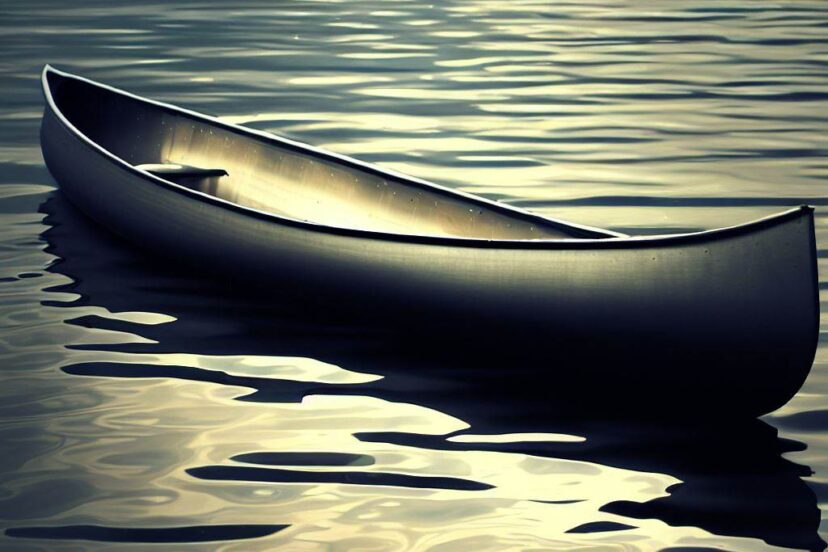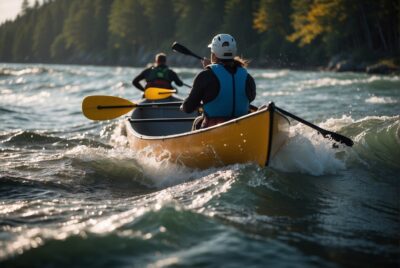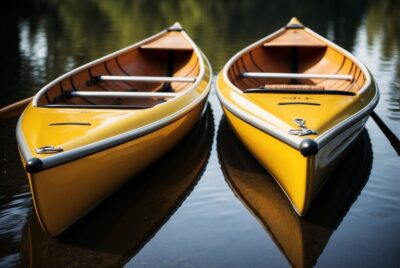Aluminum Canoes: Deep Dive
*We may earn a commission for purchases made using our links. Please see our disclosure to learn more.
Aluminum Canoes: Advantages and Selection Guide
Aluminum canoes offer a unique blend of durability, stability, and ease of maintenance that appeal to many paddlers. My experience with these vessels underscores their practicality for both recreational and sporting activities. Crafted from a lightweight yet sturdy metal, aluminum canoes are known for their longevity and resistance to damage. Whether I’m navigating calm lakes or contending with challenging river currents, aluminum canoes present a reliable choice owing to their solid construction and ability to withstand various conditions without significant wear and tear.

Recreational canoeing has become increasingly popular, and aluminum canoes play a significant role in this upsurge. They cater to an array of activities, from fishing to leisurely paddles, providing a versatile option for enthusiasts like me. Their buoyancy and balance make them suitable for family outings, where stability is key to accommodating paddlers of all skill levels. Aluminum canoes also require minimal upkeep compared to their fiberglass or wooden counterparts, making them a convenient option for those who prefer to spend more time on the water than on maintenance.
My selection process for an aluminum canoe focuses on a harmony of performance and comfort. The market offers various models that tailor to different needs, such as solo paddling or team expeditions. I consider aspects like weight, length, and design to suit my paddling objectives. Despite the range of models, the common thread across all aluminum canoes is their resilience; a trait that assures me of a long-lasting vessel ready for countless adventures.
History and Development of Aluminum Canoes

In my study of outdoor recreation, I’ve uncovered the transformative role of aluminum in canoe construction. This material’s unique properties facilitated a new era in both recreational paddling and long-distance canoe tripping.
Origins and Advancements
Aluminum canoes emerged in the first half of the 20th century, riding the wave of technological expertise following World War II. I’ve learned that Grumman, originally an aircraft manufacturer, played a pivotal role in popularizing aluminum canoes due to the metal’s abundance post-World War II. They had the advantage of being more durable and requiring less maintenance compared to their wooden counterparts.
Significant to their development was the evolution of manufacturing techniques which made aluminum canoes not only more affordable but also lighter. Over time, designs improved, with the introduction of keels and ribs to strengthen the hull and yet maintaining the lightweight characteristic that aluminum is known for.
Significant Manufacturers and Models
Without a doubt, Grumman stands out as one of the most iconic brands. They were the largest canoe maker in the United States by 1947 and offered models at competitive prices. For example, a Grumman canoe in regular trim sold for $157 compared to the $199 price tag for an Old Town OTCA at the time.
Another noteworthypmanrppis Osagian, which holds a reputation for crafting quality aluminum canoes suitable for a range of paddling experiences. Paddling Magazine and other specialized publications often reference these manufacturers, attesting to the enduring legacy of their models in the story of aluminum canoeing. Here’s a quick summary of key players and their contributions:
| Manufacturer | Notable Advancements | Impact |
| Grumman | Affordable pricing, durability | Popularized aluminum canoes post-World War II |
| Osagian | Quality construction, variety in models | Sustained the popularity of aluminum canoes |
By taking into account such specifics, it’s clear how aluminum reshaped the canoe industry and the paddling experience for many enthusiasts.
Design and Materials

When discussing aluminum canoes, it’s essential to recognize that their design and the materials used play pivotal roles in their functionality and performance. I’ll examine the specifics of aluminum alloy construction and compare it with its wooden and plastic counterparts regarding many factors such as durability and weight.
Aluminum Alloy Construction
Aluminum canoes are renowned for their use of aluminum alloy in their construction due to its resistance to corrosion and the minimal maintenance it requires. This material is often stretch-formed, a process where sheets of aluminum are shaped over a mold to create the hull. The nature of aluminum provides a good balance of strength and lightness, contributing to the overall durability and handling of the canoe. While aluminum canoes are not the lightest on the market, they strike a good balance between weight and resilience.
Comparative Analysis: Aluminum vs Wooden vs Plastic Canoes
| Material | Durability | Weight | Maintenance |
| Aluminum | High | Medium | Low |
| Wooden | Medium to High | Heavy | High |
| Plastic | Medium | Light | Medium |
Wooden canoes are traditional and can last for many years with proper care. However, they tend to be heavier than aluminum and plastic canoes, and require regular maintenance to protect against elements and wear. On the other hand, plastic canoes are generally lighter than aluminum, but they might not offer the same level of durability. Plastic can deform over time and is more susceptible to damage from impacts or prolonged exposure to the sun.
My focus on aluminum canoes centers on the pragmatic aspects that users will appreciate: a solid build that withstands various conditions with less frequent upkeep. This blend of features solidifies aluminum canoes as a versatile choice for enthusiasts and professionals alike.
Types and Uses

In this section, I discuss the different types of aluminum canoes and their specific uses, which cater to various preferences and activities. Whether it’s a leisurely solo paddle on a calm lake or a tandem sporting adventure, choices vary to suit each person’s needs.
Recreational vs Sporting Canoes
Recreational Canoes:
- Usage: Typically designed for calm waters such as lakes and slow-moving rivers.
- Features: They have a wider beam for stability, making them ideal for beginners or leisure paddlers.
- Users: Common among families and individuals interested in casual paddling or simple water-based activities such as photography.
Sporting Canoes:
- Usage: Engineered for more challenging environments like choppy waters or for sport-related activities including fishing and hunting.
- Features: These canoes are often narrower and longer, designed for better speed and maneuverability.
- Users: Preferred by sportsmen, anglers, and hunters who require a sturdy and responsive boat.
Solo and Tandem Options
Solo Canoes:
- Design: They are lightweight and streamlined, making them easy for one person to handle both on and off the water.
- Advantage: Enables the solo paddler to have complete control, perfect for those who prefer solitude or are paddling in areas where maneuvering space is limited.
Tandem Canoes:
- Design: These are typically longer and can accommodate two or more paddlers, balanced for coordinated propulsion.
- Advantage: Suitable for pairs looking for a shared experience or needing to distribute the weight of gear and supplies evenly.
Maintenance and Care

Ensuring the longevity of my aluminum canoe requires regular maintenance and proper care. I focus on its inherent durability and ease of repair, as well as specific cleaning and storage protocols. These practices help me to keep my aluminum canoe in optimal condition for years of use on the water.
Durability and Reparability of Aluminum Canoes
My aluminum canoe is impressively durable, capable of withstanding impacts that might damage other materials. Despite this strength, there are times when repairs are necessary. I approach these situations with confidence due to the repairable nature of aluminum. If I encounter a dent or a minor puncture, I can often repair it myself with basic tools and patching materials.
- Dent repair process:
- Assess the dent size.
- Apply heat gently if needed to soften the area.
- Use a mallet to carefully smooth out the dent from the inside.
- Puncture repair steps:
- Clean and sand the affected area.
- Cut a patch of aluminum sheet to size.
- Use a metal-specific adhesive or rivets to secure the patch in place.
Cleaning and Storage
Keeping my aluminum canoe clean is not only about aesthetics; it is about preserving its condition. I follow a straightforward cleaning routine after each outing to prevent build-up of residues and potential corrosion over time.
- Mix a mild detergent with water to create a gentle cleaning solution.
- Use a soft-bristle brush or sponge to apply the solution, scrubbing in a circular motion.
- Rinse thoroughly with clean water to remove any soap residue.
- Dry completely to avoid water spots or oxidation.
For storage, I ensure my canoe is protected from the elements. I store it upside down on a rack or sawhorses, which prevents water accumulation and distributes the weight evenly, avoiding deformation.
- Proper storage checklist:
- Store in a cool, dry place away from direct sunlight.
- Ensure it is upside down and elevated to prevent ground moisture contact.
- Cover it with a breathable tarp to prevent dust and debris, but avoid plastic which can trap moisture.
Choosing the Right Aluminum Canoes

When selecting an aluminum canoe, my focus is on finding a balance between size, performance, and convenience. I prioritize models that are stable, have sufficient capacity for passengers and gear, and match the intended use, whether that’s serene lake paddles or adventurous river excursions.
Factors to Consider with Aluminum Canoes
- Length and Width: I consider the length and width of the canoe as key determinants of performance. A canoe around 15 to 17 feet long usually suits my needs for one or two paddlers. Typically, wider canoes (around 36 inches) are more stable, while narrower ones are faster.
- Weight and Capacity: I look at the weight of the canoe because it affects transportation and maneuverability. Aluminum canoes can weigh from 50 to 95 pounds. They are also robust, often with a capacity of up to 650 pounds, accommodating two adults and gear comfortably.
- Stability and Performance: I opt for a stable canoe which is crucial for safety. Aluminum canoes tend to be very stable and are well-regarded for their overall strength and durability.
- Seats: Proper seating is necessary for my comfort and control. I ensure that the seats are positioned to keep the canoe well-balanced.
Accessories and Enhancements
- Gear Storage: To safeguard my gear, I choose canoes with secure storage options. This might include built-in compartments or adaptable spaces where I can attach aftermarket storage systems.
- Add-ons: I might enhance my canoe with mountable accessories such as rod holders, GPS units, or additional seats for versatility.
By carefully considering these aspects, I am confident in selecting a canoe that is tailored to my specific preferences in terms of size, comfort, and function.
Frequently Asked Questions
In this section, I’ll cover some of the most common questions about aluminum canoes, offering concise and reliable information based on my knowledge and the market research.
1. What are the top-rated aluminum canoes on the market?
Some of the top-rated aluminum canoes I know of include the Michi-Craft T-15 Aluminum Canoe for all-around use, the Waterstream X-13 Wide Transom Canoe for sportsmen, and the Grumman 17′ Double-End for families. For solo canoeists, the Osagian 12 Solo is a standout choice.
2. How does the weight of aluminum canoes compare to other materials?
Aluminum canoes typically weigh between 60 and 75 pounds. They are generally lighter than wooden canoes but heavier than those made from composite materials like Kevlar, which can be around 20% lighter than similar fiberglass or aluminum models.
3. What are common maintenance tips for aluminum canoes?
Regular cleaning with a mild detergent and water prevents build-up of debris. For stubborn stains, use a soft-bristle brush and scrub in a circular motion. To maintain shine, apply a marine-grade polish or car wax to a clean, dry canoe using circular motions.
4. How does the performance of aluminum canoes differ from fiberglass canoes?
Aluminum canoes are highly durable and less affected by impacts. They are also maintenance-friendly compared to fiberglass canoes. However, fiberglass canoes may offer better performance in terms of speed and agility due to their lighter weight and smoother finish.
5. What factors should be considered when buying a used aluminum canoe?
When buying a used aluminum canoe, inspect it for dents or repairs, which can affect performance and durability. Check the keel line for straightness as bends can indicate damage from collisions. Prioritize canoes with minimal repairs and those that have been well-maintained.




